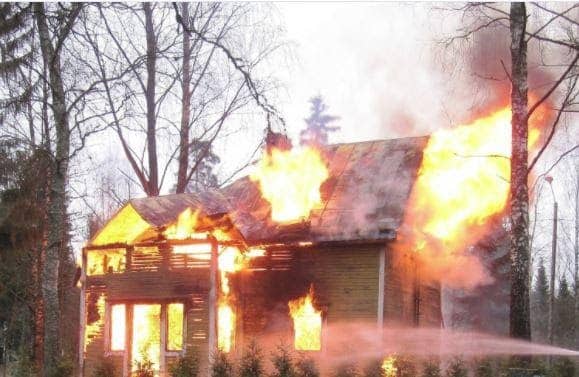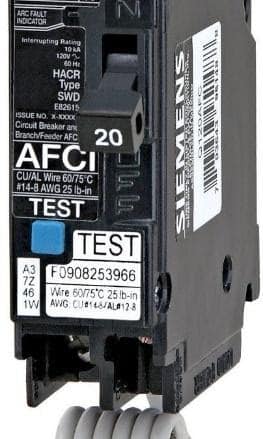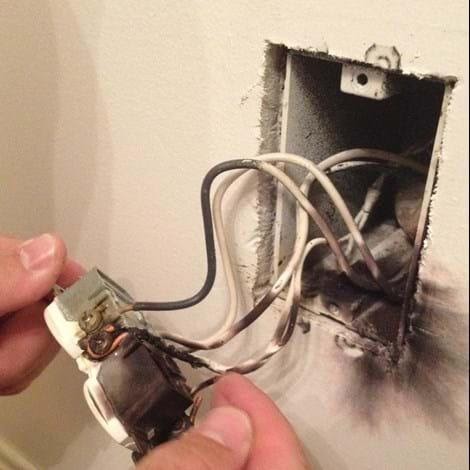What Is an Arc-Fault Circuit Interrupter?
An arc-fault circuit interrupter, professionally installed, can save lives as well as property. Unlike ground-fault circuit interrupters, designed to protect people from electric shock or lethal electrocution, an arc-fault circuit interrupter (AFCI) is an electrical safety device designed to protect property and people from home fires. An arc-fault circuit interrupter carries a small printed circuit board and electrical sensors specifically designed to identify arcing waveforms and subsequently disconnect power from the electrical circuit. By cutting power quickly, the AFCI either prevents a fire from beginning, or allows a small fire to potentially self-extinguish before spreading to the structure. AFCI protection was first introduced with the 1999 National Electric Code (NEC) and has since been revised, further expanding protection to more rooms and areas within the home. The National Fire Protection Association (NFPA) has already found a 15 to 20 percent reduction in injuries and fatalities since the implementation of arc-fault circuit interrupters. Additionally, NFPA estimates 50 percent of residential home fires can be prevented by installation of AFCI protection in accordance with NEC guidelines. Like Ground-Fault Circuit Interrupters (GFCI), AFCIs are available both in circuit breaker format or as a receptacle. The circuit breaker device is generally marked “AFCI” with a test button and pigtail wire connection. The curly white wire connects the AFCI circuit break to the grounded “neutral” bar inside the electrical panel. This allows sensors to monitor for arc waveforms and provides power to the onboard circuit board. The arc-fault circuit interrupter receptacle performs the same function as the circuit breaker but only on a portion of the electrical circuit.
Background and Development of AFCI Protection
The U.S. Consumer Product Safety Commission (CPSC) conducted numerous studies in the 1980s and 1990s focused on the causes of residential electrical fires. During that time CPSC estimated there were more than 42,000 electrical home fires each year resulting in half a billion dollars in property losses, and more than 1,800 people injured or killed. 
Causes of Electrical Arc-Faults and Life Safety Precautions
The primary causes of electrical arcs include degradation of home wiring due to nicked wires from staples, drilling, and screws, or overheating of a circuit degrading wire insulation through carbonization. Additionally, old flexible extension cords, and loose connections are common sources of arcs. There are two types of arcing conditions, parallel and series. Parallel arcs are generally higher ampere faults, and occur due to a short circuit across different wires such as from the ungrounded “hot” conductor to the grounded “neutral” conductor or the equipment grounding conductor. A parallel fault is often seen in frayed extension cords and wires. In contrast a series arc happens at a much lower ampere level and occurs in line of a single conductor, such as an inline break of a wire or a loose connection at an electrical terminal. Series arcing is much more dangerous because standard circuit breakers generally do not detect the arc event because the condition is at a much lower ampere level. Without proper detection, the arc can continue indefinitely until a structural fire occurs.
Electrical arcs pose significant fire hazards for three reasons. One, standard circuit breakers do not detect when an electrical arc is happening and therefore do not trip or interrupt the power source. Two, most electrical arcs are concealed behind walls, ceilings and floors and therefore go unnoticed until a catastrophic fire is discovered. Three, an arc event generates extreme heat and can reach temperatures in excess of 10,000 Fahrenheit producing molten metal particles and burning fragments. Copper vapor expands from solid to a vapor by 67,000 times and can create a pressure wave in excess of 1,000 pounds per square inch (psi). Electrical arcs often result in burning away or pyrolyzing wire insulation which often result in ground-faults or short-circuit conditions.
Does My Home Have Adequate AFCI Protection?
A report from the U.S. Fire Administration found bedrooms and kitchens as the two leading locations where electrical fires originate. Initially, AFCI protection was limited to bedrooms only, with later NEC revisions greatly expanding arc fault protection throughout the home. Specifically, in 2008, AFCI protection expanded to 11 additional locations in the home including living rooms, and dining rooms, with the most recent additions in 2014 adding kitchens and laundry rooms. Homes built prior to 1999, which account for the vast majority of housing stock in the United States, were not equipped with any arc-fault protection at the time of their construction. This leaves the vast majority of homes at much higher risk of electrical fires. Additionally, the NEC does not require home upgrades to electrical infrastructure unless a significant extension of a circuit is made, or repair or renovation that affects the electrical system. Given the rapid changes to the breadth of AFCI protection, coupled with the grandfathered status of most American homes due to their construction date, it is unlikely your home has an adequate level of electrical arc fault protection.
Electrical Surge Protection for Arc-Fault Circuit Interrupters
Because AFCI devices possess delicate onboard circuit boards and electrical sensors, arc-fault circuit interrupters, like other household electronics, are sensitive to electrical surges and disruptions. Common causes of residential electrical surges include utility switching, electrical service interruption, and indirect lightning strokes. Electrical disruptions, power quality issues, and electrical surges can all damage the internal circuitry of an arc-fault circuit interrupter. Once damaged, the AFCI at best no longer provides electrical arc fault detection and interruption, at worst begins nuisance tripping regularly. Best practice is to install a whole home electrical surge protection device (SPD) anytime AFCI protection is present in the home’s electrical wiring.
Home Performance Group AFCI Installation in Kansas City
Need, or simply want, arc-fault protection in your home? Not sure you have AFCIs in the correct rooms or spaces? Consider hiring a full-service electrical expert with specialized knowledge to properly inspect, recommend, and install arc-fault protection in your home. A small upfront investment in careful contractor selection can protect your home from catastrophic loss.
At Home Performance Group, we continue to invest in technical electrical training so our team can correctly diagnose, inspect, specify, and install arc fault protection and systems. We have performed numerous jobs for our clients.
If you are interested in a no-cost in-home consultation, schedule with a Solutions Advisor today.

Article by Larry L. Motley Jr., 29 November 2021
Larry is a graduate of both Wentworth Military Academy and Missouri Western State University earning a double bachelor’s degree in Economics and Finance. Additionally, he maintains six professional tradesman licenses in two states and advanced credentialing in green technology, project and program management, and process improvement. Larry is a three-time combat veteran having served in Operation Iraqi Freedom, Operation New Dawn, and Operation Inherent Resolve. He continues to serve through a value-based building science company focused on providing clients the best design, highest quality installation, and most honest repair services in the community.


Featured Service Areas:
| Missouri | Kansas | ||||
|---|---|---|---|---|---|
|
Belton Blue Springs Cameron Excelsior Springs Gladstone Holt |
Independence Kansas City Kearney Lathrop Lawson Lee's Summit |
Liberty North Kansas City Parkville Platte City Plattsburg Polo |
Raytown Riverside Smithville Sugar Creek Weston |
Kansas City Lansing Leavenworth Leawood Lenexa |
Merriam Mission Mission Hills Praire Village Shawnee |
























